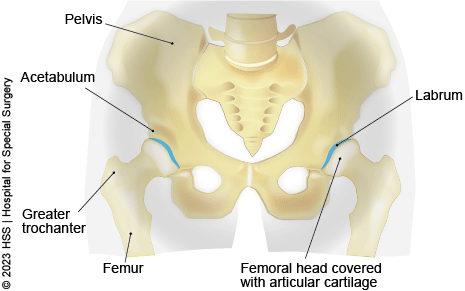Hip Impingement

Hip impingement (sometimes also called hip impingement syndrome but technically known as femoroacetabular impingement) is a mechanical problem of the hip joint that can cause stiffness, hip pain, groin pain and/or low back pain. The problem relates to how the ball of the hip fits into the socket.
Anatomy of the hip
A brief overview of hip anatomy is helpful in order to explain hip impingement. The hip is a ball-and-socket joint composed of two bones connected by cartilage, ligaments, tendons and muscles:
- the femoral head or tip of the femur (thighbone) is the ball
- the acetabulum, a cup on the side of the pelvis, is the socket

A protective layer of cartilage lines the ball and socket to allow the leg to glide smoothly backward, forward, and sideways. An additional ring of specialized cartilage in the acetabulum called the labrum further protects and stabilizes the joint. In a normal hip, there is a smooth gliding motion between the femoral head and the acetabulum within the socket. When there is impingement, the gliding motion is disturbed, and normal hip motion is restricted.
What is hip impingement?
Hip impingement is a condition in which there is abnormal alignment of and contact between the bones that form the ball and socket of the hip joint. When these do not fit well together, friction can damage the joint and cause injury to surrounding structures.
What are the symptoms of hip impingement?
The problem can go unrecognized for years since it is generally not painful in its early stages. Symptoms usually arise sometime between adolescence and middle age, especially in active people. People with hip impingement often feel pain in the groin after prolonged sitting or walking. Many athletes describe pain in the groin with deep flexion or rotation of the hip during activity. Occasionally, a popping or clicking in the front of the hip is described. Pain may also radiate along the side of the hip and upper thigh to the buttocks or even the lower back.
It is important to rule out other possible causes of pain in these areas, such as hip dysplasia, a labral tear, or sciatica.
What causes hip impingement?
The most frequent type, called a cam lesion or cam-type impingement, is caused by deformity of the femoral head or neck, where extra bone grows around the top of the femur (thighbone). Another type, known as a pincer lesion or pincer-type impingement, happens when the rim of the hip socket has grown excessively, or when the socket is tilted in such a way that friction between the bones of the joint cause damage to the articular cartilage or labrum.
How is hip impingement treated?
Treatment of hip impingement begins with conservative, nonsurgical methods. Rest, activity modifications, careful use of anti-inflammatory medications, and a course of physical therapy are often successful in alleviating symptoms. An injection in the hip joint of anesthetic and a corticosteroid can provide some pain relief as well as additional diagnostic information in patients who have symptoms that are unresponsive to treatment. When surgery is necessary, hip impingement can usually be treated with hip arthroscopy or an osteotomy. Learn more in the articles below, or find a doctor at HSS who treats hip impingement.
Hip impingement overview and diagnosis articles
Articles on surgical procedures to treat hip impingement
Articles on related conditions and issues
In the news
Updated: 10/12/2023
Reviewed and edited by Shevaun Mackie Doyle, MD
